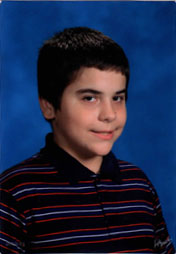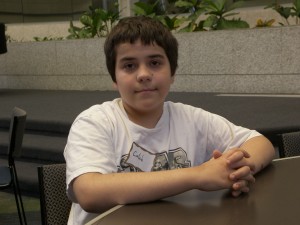Oct 20, 2012 – Fort Belvoir, VA. As the conference title suggests, this gathering was intended to give hope to those with essential tremor (ET), a condition estimated to affect a high number of Americans, approximately 10 million according to recent literature. There are likely many more who do not know they have it perhaps attributing their shaking hands to being nervous. They may attempt to control it and hide it, rather than seek treatment from a neurologist or more specifically a movement disorder specialist.
There were sixty-two in attendance mostly from area ET support groups in Silver Spring and Columbia, MD and Falls Church and Landsdowne, Virginia. The conference speakers were Dr. Codrin Lungu (Deputy Clinical Dir of Clinical Research), who runs the Parkinson’s Clinic and the medical side of the Deep Brain Stimulation (DBS) program at the National Institute of Neurological Disorders & Stroke; Dr. Claudia Testa (Associate Director Clinical Care and Research, Virginia Commonwealth University, Parkinson’s & Movement Disorders Center); and Dr. Mark Hallett (Chief, Motor Control Section, NINDS).
Peter Muller, Executive Director of HopeNET, a foundation working to increase awareness of ET, gave the opening remarks and let us know the latest about a fairly new procedure called MRI Focused Ultrasound. The University of Virginia did a pilot trial in 2011 whereby mri focused ultrasound surgery was performed on fifteen patients and it must have been seen as a success as evidenced by the 6000 on the waiting list for the procedure. Muller expressed excitement for this technology and introduced Jessica Foley, Scientific Director of the Focused Ultrasound Society. He also introduced Deb Zeller, the President of the Virginia School Nurses Association. HopeNET is jointly working with Ms Zeller on a project to develop a Careplan for use by school nurses with children who have ET.
Muller has been instrumental in bringing people with the condition closer to the medical community in a search for treatment, therapies and ultimately a cure, first in his position as a Community Ambassador to the International Essential Tremor Foundation and now for HopeNET. Muller told the group about the series of surveys being conducted by HopeNET and Tremor Action Network to answer questions on the various symptoms and treatments for ET. The last survey in French was sent to 1400 in France, Belgium and Quebec, Canada.
The first speaker, Dr. Lungu, explained in detail the procedure deep brain stimulation (DBS), a surgical option for those with significant tremor that does not respond to medication. DBS was first performed on an ET patient but now is more often used for another more well-known movement disorder, Parkinson’s Disease. DBS is “electrical therapy” for tremor and is like a pacemaker for the brain that intervenes and normalizes the electrical signals thrown off by disease, as Lungu explained it. DBS is brain surgery that involves drilling two holes in the skull the size of a dime and running electrodes to the deep structures of the brain to block the abnormal signals at the thalamus. The wires run from the thalamus (at a point called the vim) down under the skin behind the ear, down the neck and meets a small battery pacemaker in front of the chest from which the voltage and frequency are chosen. Dr. Lungu made it clear that this surgery ‘is the process, not the event,’ as he said one of his colleagues puts it. The event is the 24/7 adjustment of the electrical stimulation from the pacemaker. There are exclusion criteria for DBS – generally healthy candidates should elect this surgery and those without depression because DBS could make it worse. People also need to know what to expect. For example, the problem is still there after DBS, it is just being covered up symptomatically. DBS has its imperfections such as the fact that the motor part of the brain is separated into left brain and right brain meaning that DBS has to be done one side at a time. The dominant side is often the side done. If a person elects to have both sides done Dr. Lungu prefers to do both sides at once rather than one side now and the other side at a later surgery. He went over the risks of the surgery and the side effects, such as very mild verbal fluency issues, and subtle balance issues.
One attendee suggested getting ET listed in items asked about in the National Health Interview Survey that the Nat’l Center for Health Statistics conducts or the Health & Nutrition Examination Survey.
Dr. Testa spoke about clinical research using genetic research to give people a better understanding of the process. Clinical research as a term means working with people to study human disease. There are clinical trials in which a new intervention is tested in people, observational trials where researchers don’t try to intervene but observe only, and then there are trials dealing with parts of people, such as blood and saliva samples to get DNA for those studies. Where do research questions come from? The researchers think about basic biology of the brain and come up with ideas, and there’s community-based research, such as the surveys HopeNET has been conducting. A VCU neuropsychologist is presently doing a needs-based survey for movement disorders that will help determine ideas on ways to proceed. ET affected individuals are encouraged to participate. Understanding disease in people means looking at the mechanisms of how things work, and then the treatments that need to be developed.
An example of traditional research, called epidemiology, studies large groups of people. A famous one is the Framingham, Mass study consisting of the entire town’s population and has been studied for forty years. The resulting information has been used to find risk factors for heart disease and others. There have also been door-to-door surveys for ET (an epidemiologist and neurologist together that examined people on the spot) in places like Turkey and Spain. In those communities four percent of those over 40 years of age were found to have ET. Another example of working with people deals with looking at the brain to understand the mechanisms involved such as imaging, MRIs or functional scans looking at blood flow. Also the brain banks at Columbia University in NY and at the Arizona Study of Aging and Neurodegenerative Disorders, study the brains donated by people with ET. Research papers from these studies have only been coming out in the past few years. VCU, where Testa works, houses the MidAtlantic Twin Registry, “an amazing resource,” she says in her genetic studies and how they play a role in ET.
Testa explained, “We don’t know of a single gene mutation that causes ET.” A lot of research has been done on the connection between a change in the gene and disease. She spoke about establishing linkages across families using DNA. She explained how the Lingo-1 gene discovered to play a role in ET, does not make protein which implies it doesn’t code (for protein) so there is more work to do to discover details about that interon area – without proteins it is more difficult to study. Testa explained the genome and the detailed clues it might hold.
Our next speaker was Dr. Mark Hallett started his talk by emphasizing people’s participation in research studies since there haven’t been many good animal models. He said trying to address the basic pathophysiology or cause of ET is necessary if a rational treatment is to be created. We still don’t understand where ET comes from so genetics is an important area to study. Hallett is of the opinion that ET is not a single entity but multiple different entities, meaning a family of diseases, which may be why it’s been difficult to find a single gene that is underlying it. Hallett explained there may be different types of ET, meaning different pathophysiologies and different therapies. In other words, ET may look the same in two different people on the outside but be different on the inside. When it comes to ET responsiveness to alcoholic beverages, some people respond with a reduction of tremor and others do not – which may be an indicator of ET subtypes. Hallett asked for a show of hands about people’s responsiveness to alcoholic drinks, in that they show an improvement in tremor when drinking alcohol. The majority of the audience raised their hands. Alcohol also can have a rebound effect, he said, whereby once it wears off the tremor returns worse, temporarily.
The Movement Disorder Society is the international society of mostly neurologists, and it has taskforces looking into different types of tremor. Hallett is on a taskforce to come up with better definitions of ET and differentiate its subtypes. Hallett went over the few drugs on the market that help ET. Primidone and beta blockers are the two most common. Sometimes they work for a while and wear off. Some anticonvulsant medicines have benefit: gabapentin, topiramate and others. He said that there is not much work going on in the active development of other drugs for ET. Before he came to the conference today he checked the clinicaltrials.gov website to see what clinical research is being done in the world, and at the moment there are zero – as in no clinical trials being done in the area of ET research. The pipeline needs to be stimulated in this regard.
He gave us the alcohol or octanol story to give a sense of what the process of drug development is like at the NIH. He cited Rodolfo Llinas, a neuroscientist who studied longer chain alcohols and patented them all – saying they would be good for treating any tremor. Octanol worked better in the animal studies than ethanol did. Octanol (an 8 carbon atom) was found to be one of the best longer chain alcohols for the condition and through studies at the NIH they realized that the octanol is metabolized or broken down in the blood into octanoic acid. How many carbons is best is the question. These studies on octanol and octanoic acid at NIH have taken about 10 years to complete. NIH received a “use patent” to support development. With a pharmaceutical company, NIH started the clinical trial process. Hallett went on to explain that the cost to do an animal toxicology test and to safely try it in humans runs approximately one million dollars. It is difficult to develop a pharmaceutical. The conclusions show that octanol was efficacious to a certain extent, without people getting drunk. At a minimum, it will take several more years for the FDA to approve octanoic acid as a drug. Octanoic acid is a component of the ketogenic diet, a special diet mostly consisting of fat given to children with very severe epilepsy. Someone discovered this diet could help and it’s been used for years. A challenge is how to administer it. It tastes terrible so time needs to be spent encapsulating it. One attendee mentioned to Dr. Hallett that long periods of fasting has helped improve his tremor. Hallett explained that when you fast, your body’s metabolism changes more toward energy from ketones than from sugars. You are converting your body metabolism to a state similar to someone on a ketogenic diet.
Hallett suggested that the alcohol interfering with the calcium channel story may not be right for explaining ET and that maybe a GABA abnormality is a better model for ET than the harmaline animal study model. Another clinical trial from France involves transcranial magnetic stimulation (TMS), external stimulation over the cerebellum that reduced the severity of tremor for a period of time. TMS was given daily for 5 days and the efficacy was for 3 months. TMS has been approved for one type of depression, refractory depression.
Questions were asked of the 3 doctors at the end of the conference. Hallett talked about how relaxation and reducing anxiety and stress help to improve tremor. The hormone, cortisol, in the body is released in response to anxiety and stress and causes the brain to shrink! Dr. Testa talked about observations of the community – the changes in anxiety for people with ET as compared with those without it. There’s a powerful pathway between the unconscious mind and mood states as well as really strong symptoms in the body. Dr. Testa suggested that maybe ET patients experience more anxiety symptoms as a result of the ET. Dr. Lungu concurred that it’s unclear whether the anxiety is part of the biological condition of the disease. Dr. Hallett was asked if there is a connection between epilepsy and ET. He responded that the pathophysiology of epilepsy is well-known. Nothing at any level, at the cellular level, at the thalamus, through EEG or neuroimaging shows a connection. In answer to the question why do the anticonvulsants like primidone, gabapentin and others work for ET, Dr Hallett said these drugs all have multiple effects but we do not know how. Dr. Hallett believes that since the prevalence of ET is high, he thinks pharmaceutical companies should be more interested in developing drugs for it. Dr. Testa said the epidemiology studies indicate age of onset is in general in older adults. Hallett said that patients can help by going to their congressman to say ET is an important concern, and there are a lot of us with the condition. Joan Marie Barringer, the Support Group Leader from Vero Beach, Florida brought up the DSM Diagnostic Statistic Manual that says many of those with tremor have social phobia.
Conference attendees were pleased with the cooperation of the local medical community at places like NIH and VCU in communicating their expertise, thoughts and findings to the ET community.
Lisa Gannon
Silver Spring Support Group




